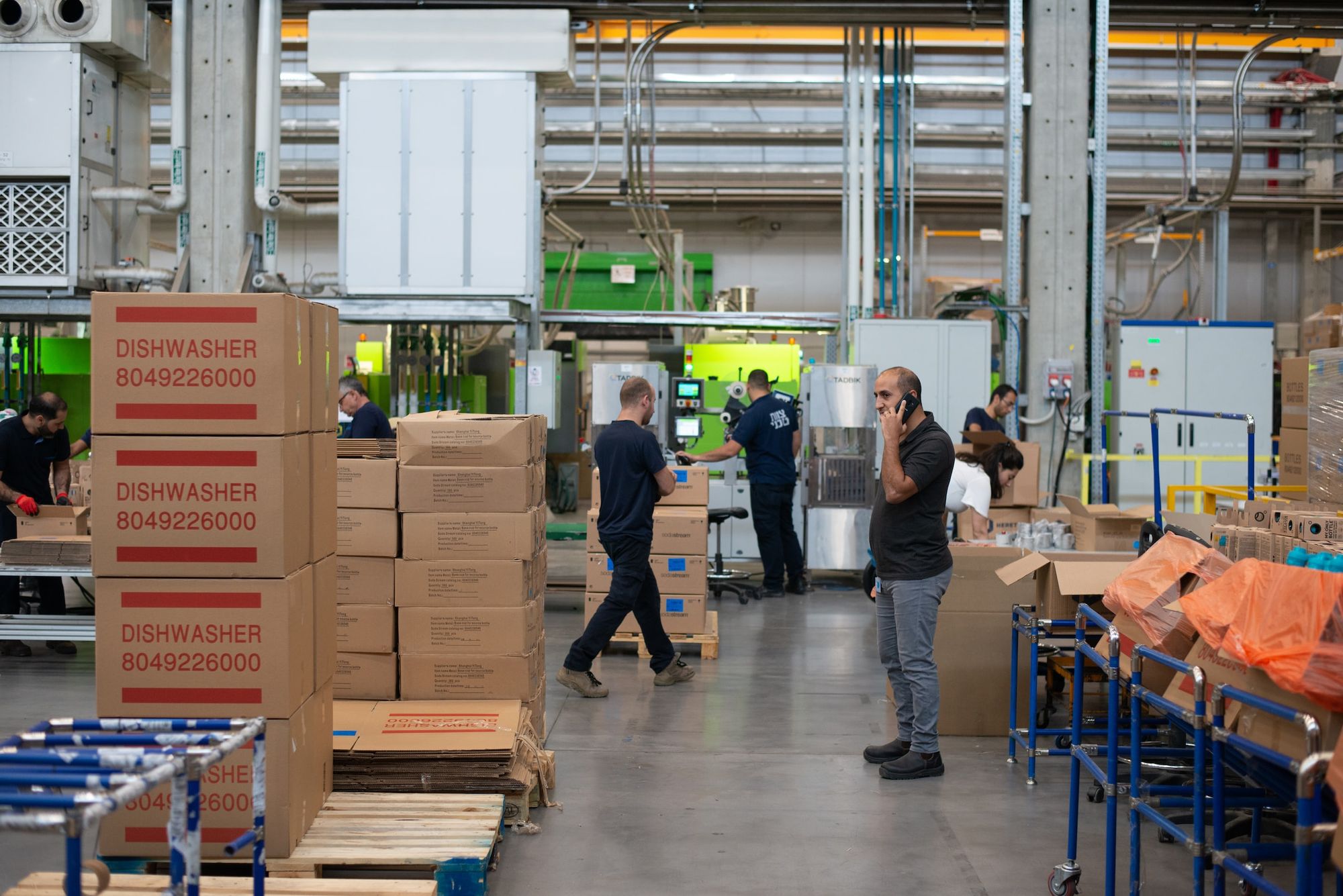Do you know what's happening in your warehouse all the time? Warehouses are complex places with a lot of moving parts. You can be wasting money and passing up opportunities if you aren't keeping track of your statistics.
The physical and financial conditions of warehouses can have a big impact on businesses. Statistics provide information about the performance of a warehouse environment, so businesses can make informed decisions about how to run their warehouses.
To maximize their operations, warehouse managers must be aware of a range of variables. These stats give them a better understanding of how their business is performing and lets them take corrective action when needed. In this article, we will take a look at some key warehouse management stats that you need to track.
Before we dive in, let's take a look at the table of content:
- Best 40 Warehouse Management Statistics
- Frequently Asked Questions (FAQs) Associated with Warehouse Management System Market
- How Deskera Can Assist You?
Let's get started!
Best 40 Warehouse Management Statistics
Following, we’ve discussed various statistics associated with warehouse management. Let’s learn:
Warehouse Management Usage
Warehouse management usage statistics can be used to measure the efficiency of warehouse operations and analyze how resources are used within a warehouse. This can assist find opportunities for cost- or quality-saving measures.
Common metrics used to measure warehouse management usage include inventory accuracy, labor utilization, order accuracy, order cycle time, and order fulfillment rate. By tracking these metrics over time, warehouse managers can identify trends and identify areas that need improvement.
Additionally, warehouse managers can use these statistics to compare their performance to industry benchmarks and to other warehouses.
Statistics:
- Using integrated order processing for their inventory system can boost productivity by 25%, space consumption by 20%, and stock use efficiency by 30% for businesses.
- While 50.1% of firms say they utilize AI just occasionally, 46% say they never use it at all.
Warehouse Management Market
Warehouse management systems (WMS) are software applications that are used to enhance warehouse operations. WMS helps in improving the process of order fulfillment, reducing operational costs and improving customer service.
Growing demand for efficient inventory management, increasing need for warehouse optimization, and rising demand for efficient warehouse operations are the key factors driving the growth of the global warehouse management market.
A crucial component of warehouse management is inventory management. Inventory management helps organizations in managing their resources efficiently.

It also helps in controlling and monitoring the movement of goods in and out of the warehouse, tracking inventory levels, and allocating inventory to various orders. This helps in streamlining the inventory management process, thereby reducing operational costs and improving customer service.
The warehouse management market is segmented based on component, warehouse type, deployment, industry vertical, and region. Furthermore, the market is divided into solutions and services based on components. The services segment is further classified into professional services, and managed services.
Statistics:
3. The market for warehouse management was valued at $4.16 billion in 2019 and is anticipated to rise to $7.90 billion by 2027, at a CAGR of 9.2%.
4. According to a supply chain market study, machine learning is used to increase forecast accuracy by 19% of companies implementing SCM projects.
5. Supply chain investment increased in 2018 due to cost reduction (25%) and SCM automation (25), as well as market expansion (23.7%).
6. The Logistics Management report states that WMS is used in 85% of warehouse operations. This rapid adoption of technology to automate activities is occurring despite space constraints and a tight labor market.
7. Despite the pandemic, a CAGR of 11.2% is predicted for the worldwide supply chain management industry from 2020 to 2027.
8. Only 63% of businesses, according to a supply chain market study, have tech solutions in place to monitor the performance of their supply chains.
9. Transportation management systems are predicted to represent $4.8 billion of the global market by the end of 2025.
10. The main supply chain market constraints are limiting cost increase (32%), fending off international competition (28%), and fulfilling customer expectations (27%).
Warehouse Management Software
Employing warehouse management software, inventory, orders, and other warehousing duties are monitored and controlled. It enables businesses to streamline their warehouse operations, reducing costs and improving efficiency. It allows warehouses to track and manage inventory, orders, and deliveries.
Furthermore, it also includes features such as barcode scanning, automated order fulfillment, and inventory management. It can also be used to generate reports and analyze data.
Furthermore, the software is typically cloud-based and can integrate with other systems such as accounting and supply chain management.
Statistics:
11. "Leaders utilize optimization software 75% of the time, visualization software 67% of the time, mobile technologies 75% of the time, and RFID tags 65% of the time, compared to followers who use optimization software just 34% of the time.
12. By 2025, SCM software will likely cost $8.08 per person monthly on average.
Warehouse Management Adoption
Warehouse management systems (WMS) are becoming increasingly popular within the supply chain and logistics industry. Organizations are increasingly adopting WMS solutions to improve warehouse efficiency, reduce costs, and increase customer service levels.
Adoption of WMS solutions can help organizations manage their inventory levels, optimize their labor force, track shipments, and automate their warehouse operations. WMS systems can also help organizations reduce the need for manual data entry, increase accuracy, and improve warehouse throughput.
Additionally, WMS solutions can provide real-time visibility into inventory levels, enabling organizations to better forecast demand and plan their supply chain operations more effectively.
Statistics:
13. WMS adoption topped 90% in 2018 for the first time.
14. According to Logistics Management, "2018 also showed a fall in the usage of paper-based picking systems, which went from 62% last year to 48% this year—the first time that use of paper-based picking dipped below 50%. This was the first year that WMS use exceeded 90%.
Warehouse Management Latest Statistics
15. In 2021, 58.6% of retail supply chain executives plan to increase their spending on omni channel fulfillment.
16. In 2021, the characteristic response share was 83%.
17. Women made 97% of what men did in 2021.
18. 46% of supply chain experts still utilize Excel spreadsheets for their business operations. if we were in 2021 or 1995.
19. Despite the pandemic, a CAGR of 11.2% is predicted for the worldwide supply chain management industry from 2020 to 2027.
20. 52% of 2020 disruptors in the first nine months of the year led to a "war room" scenario.
21. A 13-percentage point increase was reported in the first nine months of 2020.
22. Executives' Plans for 2020 to Improve Logistics and Transportation Resilience Executives want to buy raw materials from two distinct suppliers, according to 53% of them.
23. In 2020, it is anticipated that overstock and out-of-inventory distortion will cost mass merchants and grocery retailers, respectively, $176.7 billion and $568.7 billion.
24. Suppliers are allegedly under pressure to satisfy e-commerce clients by providing a variety of goods in smaller sizes more rapidly as U.S. e-commerce sales continue to increase at a rate of over 15% annually.
25. 50% of manufacturing supply chains are anticipated to be capable of sending goods straight to customers' homes by 2020.
26. Between 2020 and 2030, the employment of logisticians will expand by 30%, which is substantially faster than the average for all occupations.
27. 79% of organizations with high-performing supply chains have revenue growth that is higher than the industry average, according to a Deloitte study on supply chain leadership.
28. The number of respondents who improved warehouse IT increased dramatically from 38% to 50% this year, even though 98% of respondents took some form of action.
29. 15% more people chose to use a 3PL than they did previously, and 15% more chose the new option, "adding automated equipment to operations."
30. According to Logistics Management, at times of normal volume, temporary workers typically make up 13.5% of the workforce.
31. The average response to the question of "about what percentage of SKUs are conveyable or could be handled robotically" from respondents was 43%, up from 29% last year, according to Logistics Management.
32. 62% of respondents said that human error in manual process management is the main cause of problems with inventory fulfillment.
33. "A total of 31% of respondents said that they are now utilizing or contemplating robotics when asked about their current use of robotics and whether they would consider it in the upcoming 24 months.
34. Daily performance (40%), cost reduction (35%), production service rate (29%), inventory turn (28%), and production time (27%) are the KPIs most frequently used for supply chain monitoring.
35. Other picking technologies and techniques are developing, according to Logistics Management, including RF assisted scanning (up 9% from 2017) and voice assisted scanning (12%, up from 7% last year).
36. According to Yale's Top 10 Warehouse Operational Metrics, the cycle time "begins when products from the supplier arrive and concludes when those commodities are stored in the warehouse and documented in the inventory management system."
37. Funding sensor technologies (12.9%), e-commerce training for retail employees (11.3%), retooling DCs (9.7%), and transforming stores into warehouses (3.2%) are also prioritized by some.
38. 36% of supply chain analysts cite improving inventory control to balance supply and demand as one of the main motivations for their profession.
39. MRO expenditures, which include things like cleaning supplies and maintenance equipment, may account for about 40% of a company's purchasing budget, according to Supply Chain Management Review.
40. Mechanisms for internal Inventory Control more effective inventory management procedures are desired by 75% of supply chain management professionals.
Frequently Asked Questions (FAQs) Associated with Warehouse Management System Market
Following, we’ve discussed some crucial frequently asked questions (FAQs) associated with the warehouse management system market. Let’s learn:
Que 1: What is the warehouse management system market growth?
Ans: The global WMS market is anticipated to increase at a compound yearly growth rate of 16.1% between 2022 and 2030, reaching USD 11.08 billion.
Que 2: What elements are at play in the market for warehouse management systems?
Ans: The primary drivers behind the expansion of the WMS industry are shifting supply chain models employed by product manufacturers and swiftly expanding customer demand, notably in the transportation and logistics and retail sectors.
Que 3: Which market segment held the most proportion of the warehouse management systems market?
Ans: With a 32.6% market share in 2021, Europe dominated the WMS market. This is brought on by the expansion of warehouse management systems on a regional scale and the rising popularity of cloud-based warehouse management systems.
Que 4: A warehouse management system (WMS) is what, exactly?
Ans: A software program called a warehouse management system (WMS) assists in managing the everyday activities.
It helps improve accuracy, efficiency, and overall productivity by automating the warehouse processes and providing essential data to warehouse managers and personnel.
Que 5: What advantages can warehouse management systems offer?
Ans: The benefits of using a Warehouse Management System include increased accuracy and efficiency, improved customer service, reduced costs, improved inventory control, better labor management, and streamlined operations.
Que 6: Which warehouse types can profit from a warehouse management system?
Ans: A warehouse management system is beneficial for all types of warehouses, including those used for manufacturing, retail, and distribution.
Que 7: What attributes ought to I consider when choosing a warehouse management system?
Ans: When selecting a Warehouse Management System, you should look for features such as real-time visibility, automated processes, integrated systems, scalability, and reporting capabilities.
How Deskera Can Assist You?
Deskera offers an ERP software solution for energy industries that is completely integrated, fully compliant, and easy to deploy. It is a web-based business management tool that offers a complete, real-time picture of your operation in the automotive sector.
Deskera Books, an accounting expert that is included with Deskera ERP, enables you to automate all of your accounting tasks, including invoicing, billing, expenses, payments, taxes, reporting, approval flows, multiple currency payments, payment getaways, generation of financial statements and KPIs, and many more.

Deskera CRM allows you to easily build up your customer base through email marketing, CTAs, landing pages, help desk choices, and other methods. Additionally, automating sales is now easy along with closing transactions, moving them through the sales pipeline at the appropriate stages, and gaining real-time dashboard analytics.
Final Takeaways
We've arrived at the last section of this guide. Let's have a look at some of the most important points to remember:
- Warehouse management usage statistics can be used to measure the efficiency of warehouse operations and analyze how resources are used within a warehouse. This can help identify areas of improvement or cost savings.
- Warehouse management systems (WMS) are software applications that are used to enhance warehouse operations. WMS helps in improving the process of order fulfillment, reducing operational costs and improving customer service.
- Warehouse management software is used to track and manage inventory, orders, and other warehousing activities. It enables businesses to streamline their warehouse operations, reducing costs and improving efficiency. It allows warehouses to track and manage inventory, orders, and deliveries.
- The number of logisticians employed will increase by 30% between 2020 and 2030, which is much faster than the average for all occupations.
- The primary drivers behind the expansion of the WMS industry are shifting supply chain models employed by product manufacturers and swiftly expanding customer demand, notably in the transportation and logistics and retail sectors.
Related Articles












